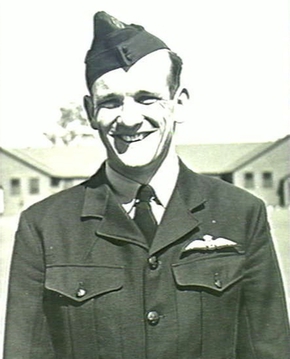
INGRAM, Ian Ross
| Service Number: | 403343 |
|---|---|
| Enlisted: | 6 January 1941 |
| Last Rank: | Flying Officer |
| Last Unit: | No. 225 Squadron (RAF) |
| Born: | Monifieth, Angus, Scotland, 12 September 1920 |
| Home Town: | Canberra, Australian Capital Territory |
| Schooling: | Not yet discovered |
| Occupation: | Public servant (clerk) |
| Died: | Flying Battle, North Africa, 29 November 1942, aged 22 years |
| Cemetery: |
Bone War Cemetery, Annaba Plot VI. Row A. Grave 16. His name also panel 124 at the AWM |
| Memorials: | Australian War Memorial Roll of Honour, Griffith Canberra Amateur Swimming Club Roll of Honour |
World War 2 Service
| 6 Jan 1941: | Enlisted Royal Australian Air Force, Aircraftman 2 (WW2), 403343, Sydney, New South Wales | |
|---|---|---|
| 6 Jan 1941: | Enlisted Royal Australian Air Force, Flying Officer, 403343 | |
| 20 May 1941: | Embarked Royal Australian Air Force, 403343 | |
| 1 Sep 1941: | Promoted Royal Australian Air Force, Airman Pilot | |
| 29 Nov 1942: | Involvement Royal Australian Air Force, Flying Officer, 403343, No. 225 Squadron (RAF), Libya/North Africa |
Help us honour Ian Ross Ingram's service by contributing information, stories, and images so that they can be preserved for future generations.
Add my storyBiography
Father Adam Ingram and Mother Jessie Jane (nee _______)
living in 9 Rous Crescent, Canberra, ACT.
Ian lived with his parents prior to enlisting.
Prior to enlisting Ian was:-
- an avid member of the CANBERRA PLATYPUS Swimming Club;
- he worked as a Clerk with the Commonwealth Public Service Board in Canberra ACT for 1.5 years
Previous Service: 3rd Infantry Battalion, Militia
Described on enlisting as 20 years 3 months old; single; 5' 11" tall; 167 lbs; medium complexion;
blue eyes; brown hair; Congregational.
6/1/1941 Completed medical at No.2 Recruting Centre, Sydney - fit for service
Enlisted in Sydney
as Aircrew V (P) at No.2 Initial Training School (ITS) in Lindfield
1/3/1941 classified as Aircrew II (P) as a Lance Corporal
6/3/1941 No.C. Elementary Flying Training School, at Narrandera
2/5/1941 No.2 Embarkation Depot
20/5/1941 Embarked from Sydney for service overseas
12/6/1941 disembarked into Canada
17/6/1941 No.2 Elementary Flying Training School, Uplands, Canada
1/9/1941 Graduated as a pilot from No. 2 Service Flying Training School at Uplands,
Ontario, Canada
Promoted to Sergeant
*** Awarded and received his "flying badge" ****
3/9/1941 No.1 Y Depot, Halifax
9/9/1941 Embarked from Canada for England
24/9/1941 disembarked into England
15/10/1941 No.40 Aircraftmen War Course
13/12/1941 completed course
14/12/1941 Granted leave
20/12/1941 returned from leave
In January 1942 the 225 Squadron received some Hurricanes for tactical reconnaissance duties.
1/4/1942 Granted leave
7/4/1942 returned from leave
In May began to convert to Mustangs. The squadron was allocated to the North African invasion
force providing tactical reconnaissance support for the 1st Army throughout the Tunisian campaign.
11/8/1942 Granted leave
24/8/1942 returned from leave
1/9/1942 No.154 Squadron
29/9/1942 Noted by Wing Commander Howard V Alloway:-
In September the Australians deployed to Libya to join the Desert Air Force which, together with the
Eighth Army, was leading the counter-offensive against Rommel.
13/11/1942 No.225 Squadron
In 1942 the 225 squadron re-equipped with Hawker Hurricanes and North American Mustangs.
After participating in the allied invasion of Tunisia "Operation Torch".
In November 1942 the squadron took part in Operation Torch, the invasion of North Africa.
By now the Mustangs had been removed, and the squadron operated a mix of Hurricanes and
Hurribombers.
It flew into Maison Blanche airfields in Algiers on 13 November, and began operations four days later.
During the campaign in North Africa the squadron flew a mix of missions. Tactical reconnaissance was
most common, but ground attack, pathfinder sorties and tactical bombing missions were also flown.
During this period the squadron converted to the Spitfire.
By late November the grim struggle once again centred on the port of Tobruk, where the allies were
under siege.
On the afternoon of the 25th, Squadron Leader Peter Jeffrey led pilots from No. 3 Squadron and the
RAF's No. 112 Squadron (which included a number of Australians) on an offensive sweep, seeking
to take the fight to the enemy. To the unrestrained enthusiasm of the onlooking allied army Jeffrey's
formation scored an important victory, shooting down seven enemy aircraft and damaging another
eight for the loss of one Tomahawk.
Several days later another intense engagement saw 20 more Luftwaffe aircraft destroyed or
damaged.
When the last Australian Army division was withdrawn from the Middle East at the end of 1942,
the RAAF remained behind.
(For the next three years the Australian pilots and ground staff fought their way northwards
through Tunisia, Sicily, Corsica, Italy, and central Europe, to the final victory over Germany.)
His service aircraft mostly flown was - DH 82 Harvard Plane.
Stated as most proficient in flying TIGER MOTH HARVARD II plane.
29/11/1942 Flying Officer Ingram was lost on operations over North Africa, while serving
with 225 Squadron RAF.
buried in: Bone War Cemetery, Annaba, Algeria
Plot VI. Row A. Grave 16.
Sourced and submitted by Sharyn Roberts and Julianne T Ryan. 28/11/2014. Lest we forget.















